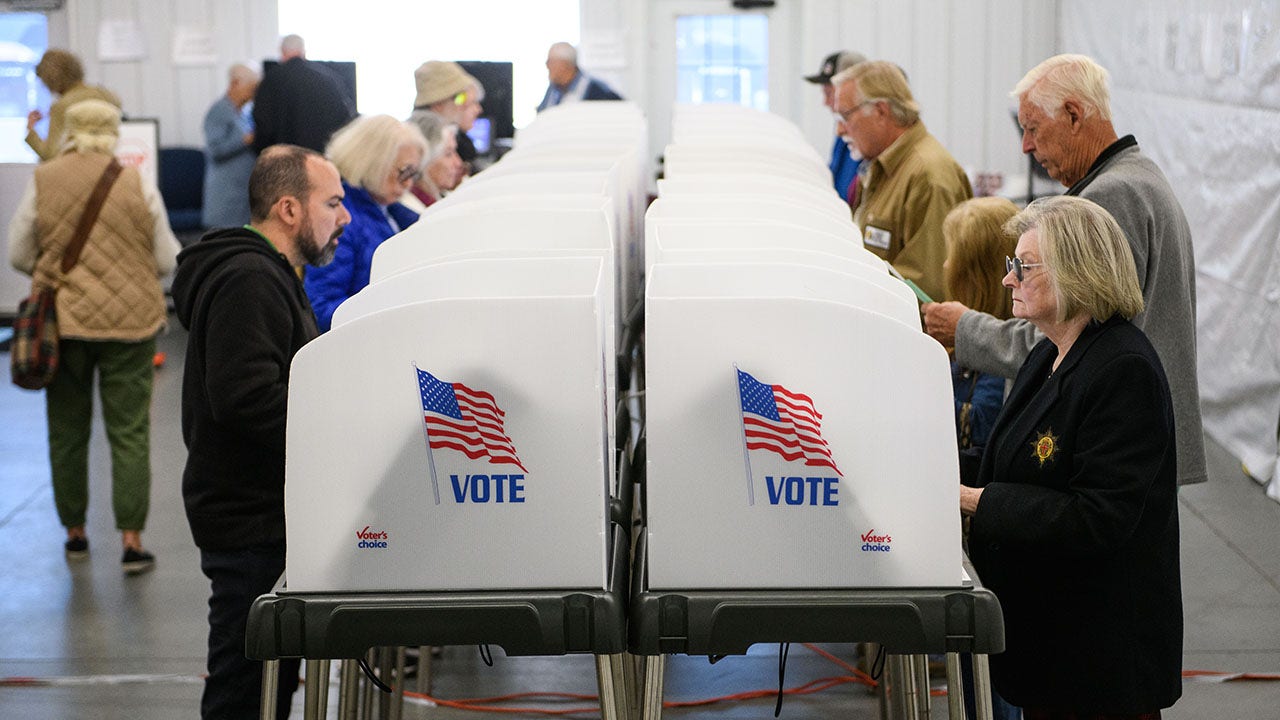North Dakota
Watch: Doug Burgum evokes western romance, North Dakota hometown values in his first presidential ad

FARGO — North Dakota Gov. Doug Burgum released his first campaign ad Monday, June 5, in his run for president of the United States.
He talks about his life, his hometown of Arthur, an energy-independent political platform and evokes many images of the Badlands in western North Dakota.
Burgum will formally announce his Republican candidacy starting at 11:30 a.m. Wednesday at the Sanctuary Events Center in Fargo.
Our newsroom occasionally reports stories under a byline of “staff.” Often, the “staff” byline is used when rewriting basic news briefs that originate from official sources, such as a city press release about a road closure, and which require little or no reporting. At times, this byline is used when a news story includes numerous authors or when the story is formed by aggregating previously reported news from various sources. If outside sources are used, it is noted within the story.

North Dakota
Obituary for Philip J. Stach at Thomas Family Funeral Home

North Dakota
Trump EPA plans to roll back Biden's carbon, mercury emissions rules that would hit North Dakota coal plants

FARGO — President Donald Trump’s administration plans to repeal two Biden-era rules that North Dakota leaders say
would threaten the state’s coal industry.
But rescinding the rule could cost lives, an environmental group said.
The Environmental Protection Agency has proposed rescinding the Clean Power Plan 2.0 and a Mercury and Air Toxics Standards, or MATS, rule, according to a release issued Wednesday, June 11. North Dakota’s congressional delegation and North Dakota
Gov. Kelly Armstrong
celebrated the development.
“Today’s action by the EPA is a win for U.S. energy dominance and supports continued access to the affordable and reliable baseload power provided by coal,” Sen.
John Hoeven,
R-N.D., said in a statement.
The EPA needs to finalize its decision to rescind the rules. It’s unclear when that may happen.
Under former President Joe Biden, the EPA approved the Clean Power Plan 2.0 in an effort to reduce carbon emissions from fossil fuels that generate electricity. Biden aimed to cut back greenhouse gas emissions and slow
climate change.
Biden’s EPA also called on coal-fired power plants to reduce the amount of toxic metal emissions released into the atmosphere. Mercury in the air can be dangerous for certain populations, including pregnant women and children, according to the Sierra Club, an environmental advocacy group.
“It’s completely reprehensible that Donald Trump would seek to roll back these lifesaving standards and do more harm to the American people and our planet just to earn some brownie points with the fossil fuel industry,” Sierra Club Climate Policy Director Patrick Drupp said in a statement. “This repeal means more climate disasters, more heart attacks, more asthma attacks, more birth defects, more premature deaths.”
Lignite coal-fired plants, like the five in North Dakota, initially had to reduce mercury emissions by 70% before July 8, 2027. Trump extended that deadline by two years after the coal industry said technology to reduce mercury emissions didn’t exist.
The MATS rule would cost coal plants in 12 states, including North Dakota, $1.2 billion over a decade starting in 2028, the EPA said in its Wednesday news release.
EPA Administrator Lee Zeldin criticized Biden’s Clean Power Plan, claiming its purpose was to “regulate coal, oil and gas out of existence.”
“Affordable, reliable electricity is key to the American dream and a natural byproduct of national energy dominance,” Zeldin said in a statement. “According to many, the primary purpose of these Biden-Harris administration regulations was to destroy industries that didn’t align with their narrow-minded climate change zealotry.
Repealing the Clean Power Plan would save the power sector $19 billion in regulatory costs, the EPA said.
U.S. Sen Kevin Cramer, Hoeven and Armstrong called the Biden-era rules an overreach. Armstrong said he met with Zeldin last month in Washington, D.C., to discuss the rules.
In a statement, Armstrong said the Clean Power Plan would “effectively shut down existing coal-fired power plants by requiring them to curb greenhouse gas emissions by 90% by 2032.” MATS threatened the power grid and would force coal plants to prematurely close, Armstrong said.
“It’s refreshing to finally have a regulatory agency that takes input from the people who produce what the world needs – and allows them to do it better than anyone else while protecting the environment,” the governor wrote.
The two rules targeted North Dakota’s energy industries, Cramer said.
“In North Dakota, we mine lignite coal and produce very reliable, long-term, steady electricity at a low cost,” he said in a statement. “I’ve always resented that somebody in this building, at EPA, thought they cared more about the air, land, water and economy than I did and my family did.”
The Biden rules would threaten the reliability of the country’s power grid and weaken national security, U.S. Rep. Julie Fedorchak, R-N.D., said in a statement.
“Under the Trump administration, the EPA is charting a new course — one that supports the responsible development of the natural resources we’ve been blessed with for the good of the American people,” she said in calling the potential repeal “a big win for North Dakota energy and American manufacturing.”
North Dakota
In third virtual town hall, Fedorchak lauds 'big beautiful bill'

BISMARCK — North Dakota’s sole member of Congress, Republican Rep. Julie Fedorchak, hosted her third virtual town hall on Tuesday, June 10, where she fielded questions and concerns from residents about the “big beautiful bill” that recently passed in the House.
“There’s a lot of misinformation that’s been spread about this legislation, and what is and isn’t included in it, and what the overall goal is,” Fedorchak said while opening the town hall just after 7 p.m. “I want to set the record straight on a couple of those things.”
The federal legislation, which is on its way to the Senate after passing in the House by a single vote May 22, outlined more than $1 trillion in spending cuts that have sparked uproar across the country.
Of the cuts to federal agencies and their programs, North Dakotans shared concerns Tuesday related to regional Veterans Affairs hospitals, JobCorps and state Medicaid programs.
A Minot resident named Thomas asked if the philosophy of government is to “shut something down” instead of “fix it” with regard to
the closing of the JobsCorps campus in Minot.
The program provides free career training and education for late teens and young adults.
Fedorchak said she supports the program’s mission and shares concerns about its status in Minot.
After meeting with Labor Secretary Lori Chavez-DeRemer to discuss the changes, however, Fedorchak said she wasn’t able to obtain further details due to the pending legal cases related to the program — lawsuits filed against the Department of Labor after the cuts were announced.
As for the VA cuts, Michelle of Fargo said she was “disheartened” by
the decision to eliminate federal funding to related care facilities.
Veterans will still receive health care, the changes merely cut out the bureaucracy created by the Biden administration, Fedorchak assured her.
Dan in Bismarck said he’s worried about
cutting back on Medicaid
and that there’s “not enough savings” in doing so “to justify the amount of cuts they’re (Congress) proposing.”
The changes include a laundry list of exceptions and are meant to save the program for people who “need it the most,” Fedorchak responded, not able-bodied people and those without permanent legal status who are currently receiving the benefits, she said.
She also emphasized her support for new work, volunteer and education requirements within the program.
When it comes to increased spending, one resident was curious about how North Dakota’s international border would be impacted by more funding for the military and U.S. Immigration and Customs Enforcement, or ICE.
Sky from Fargo expressed concern about the state’s dependency on workers who lack permanent legal status, namely for agriculture industries.
“A lot of our farmers, we’re an ag state, depend on a lot of these illegal immigrants. What’s going to be done so they can continue staffing so our economy doesn’t take a hit?” she asked.
Fedorchak said she hopes farmers are hiring legal workers, and that she is a proponent of making the visa process more efficient.
Alternative energy sources and how they relate to regional grid stability also came up intermittently.
Gordon, a wind turbine technician based in McKenzie, pointed to Trump’s distaste for wind energy and asked if Fedorchak felt the same. It was not clear if Gordon was from McKenzie County, or the unincorporated community in Burleigh County. Another caller from Fargo, Paul, was curious about moving to geothermal energy to strengthen the grid, pointing to the state’s “treasure trove” of it as a resource.
While Fedorchak said she supports eliminating existing tax credits for wind and solar energy, she also supports making the permitting process of all energy resources, including that of wind and geothermal resources, faster.
“Each resource has pros and cons and having a mix of them and a blend of them is best,” she said.
There were fewer viewers on Facebook during Tuesday’s town hall compared to the previous live streams, with the listener count not exceeding 50. The comment section was turned off by Fedorchak’s Facebook page.
Fedorchak is the only member of the state’s federal delegation who has hosted town halls since President Donald Trump was elected. Republican Sens. Kevin Cramer and John Hoeven have not announced any plans to host public forums in the near future.
-

 West6 days ago
West6 days agoBattle over Space Command HQ location heats up as lawmakers press new Air Force secretary
-

 Alaska1 week ago
Alaska1 week agoInterior Plans to Rescind Drilling Ban in Alaska’s National Petroleum Reserve
-

 Technology1 week ago
Technology1 week agoMicrosoft will finally stop bugging Windows users about Edge — but only in Europe
-

 Politics1 week ago
Politics1 week agoRed state tops annual Heritage Foundation scorecard for strongest election integrity: 'Hard to cheat'
-

 World1 week ago
World1 week agoTwo suspected Ugandan rebels killed in Kampala explosion
-

 Culture1 week ago
Culture1 week agoDo You Know the Jobs These Authors Had Before They Found Literary Success?
-

 Politics1 week ago
Politics1 week agoTrump pushes 'Big, Beautiful Bill' as solution to four years of Biden failures: 'Largest tax cut, EVER'
-

 World1 week ago
World1 week agoEU trade chief to meet US counterpart in Paris amid tariff tensions

















